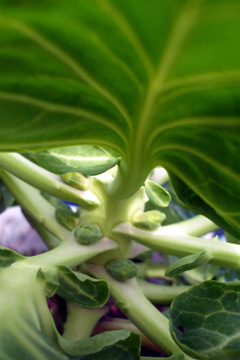 story by Char VandermeerBy now there have likely been a few casualties in your garden. But like the Boss says: “Everything dies, baby, that’s a fact.” It would be a shame to let those containers gather dust until next spring, though, so clean them out, find some fresh, fertile, nitrogen-rich dirt, and get your brassica veggies growing.
story by Char VandermeerBy now there have likely been a few casualties in your garden. But like the Boss says: “Everything dies, baby, that’s a fact.” It would be a shame to let those containers gather dust until next spring, though, so clean them out, find some fresh, fertile, nitrogen-rich dirt, and get your brassica veggies growing.
Thanks to climate change, Philadelphia was recently promoted to a new zone on the USDA’s Plant Hardiness Zone Chart. The chart is the standard gardeners and growers follow to decide which plants are most likely to thrive in their geographic area. One of the benefits (if you can call it that) of this climate-change-spurred promotion is that Brussels sprouts, broccoli, kohlrabi, cabbage and other members of the brassica family aren’t restricted to early spring plantings anymore. In fact, they’re good candidates for fall replacement plantings, if you don’t mind a little gambling.
Timing’s everything with the brassica clan, and this weather wackiness makes determining a safe planting time for fall crops a guessing game at best. So, with that disclaimer in mind, I’ll give it my best shot.
Once August rolls around, it’s probably too late to consider growing Brussels sprouts and kohlrabi from seed (trust me, I’ve tried). But nice, healthy starts can still do well. Pay a visit to a real nursery, such as Primex or Greensgrow (please don’t go to a box store), and ask around for varieties they’d recommend.
If you’re planning way ahead, and it’s still July, what the heck, give seeds a shot! Look for early-maturing cultivars like Franklin Brussels sprouts, Early Purple or Grand Duke kohlrabi, and stress-tolerant broccoli varieties like Arcadia. Assuming Philly’s first frost is—as the Farmers’ Almanac and last couple seasons predict—in mid-November to sometime in December, you can direct-seed your broccoli. So start these indoors 85 to 100 days before the first frost. I’ve found that Brussels sprouts and kohlrabi are a little more finicky, and prefer a nice, climate-controlled start. Plants can be safely transplanted into their final resting pot when they’re about three inches tall or have four to six mature leaves.
Brassicas love cooler temperatures, ideally with highs in the 60s or 70s, and in many cases, their flavor improves after a light frost—evidently there’s something about the colder temperatures that convert starches to sugars. Be prepared to keep the soil nice and moist; mulch works well both to conserve water and protect from extreme day-to-night temperature shifts.
You’ll still have to keep your eyes peeled for bugs, though. Be sure to flip the leaves over and inspect the undersides carefully—this is where the creepy crawlies like to hide. Soapy sprays work well on aphids, and cabbage loopers (pesky garden-eating worms) move a little more slowly in the fall, so you should be able to handpick them before they wreak too much havoc.
Char Vandermeer tends a container garden on her South Philly roof deck; she chronicles the triumphs and travails at plantsondeck.com


